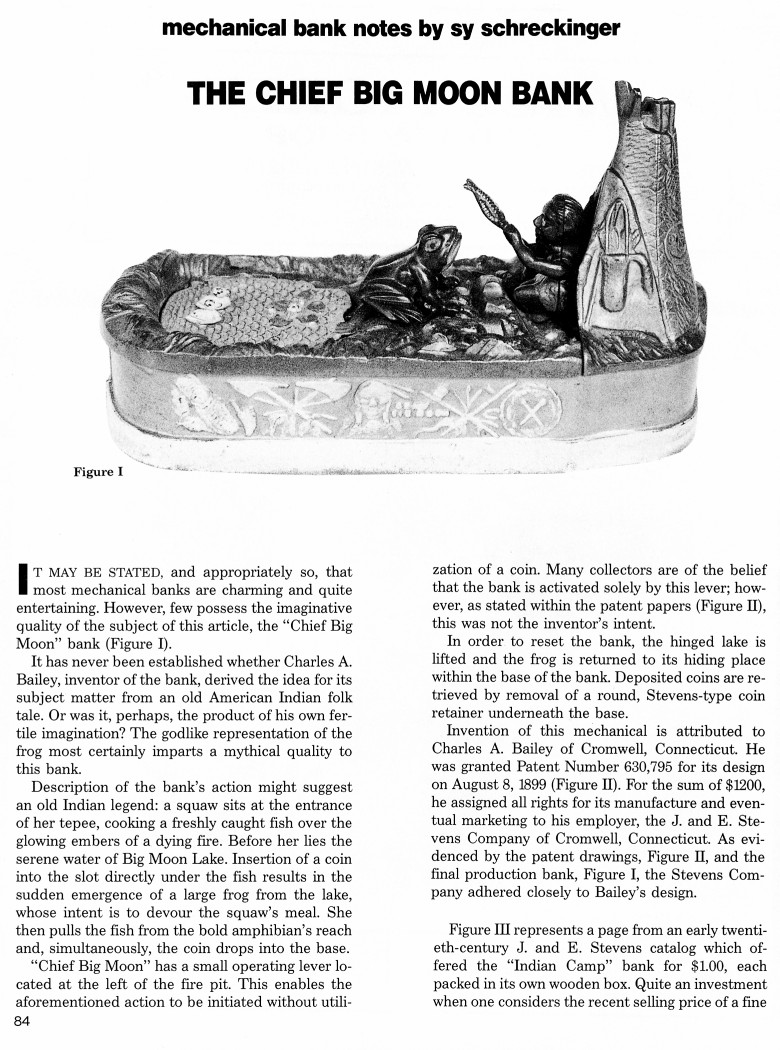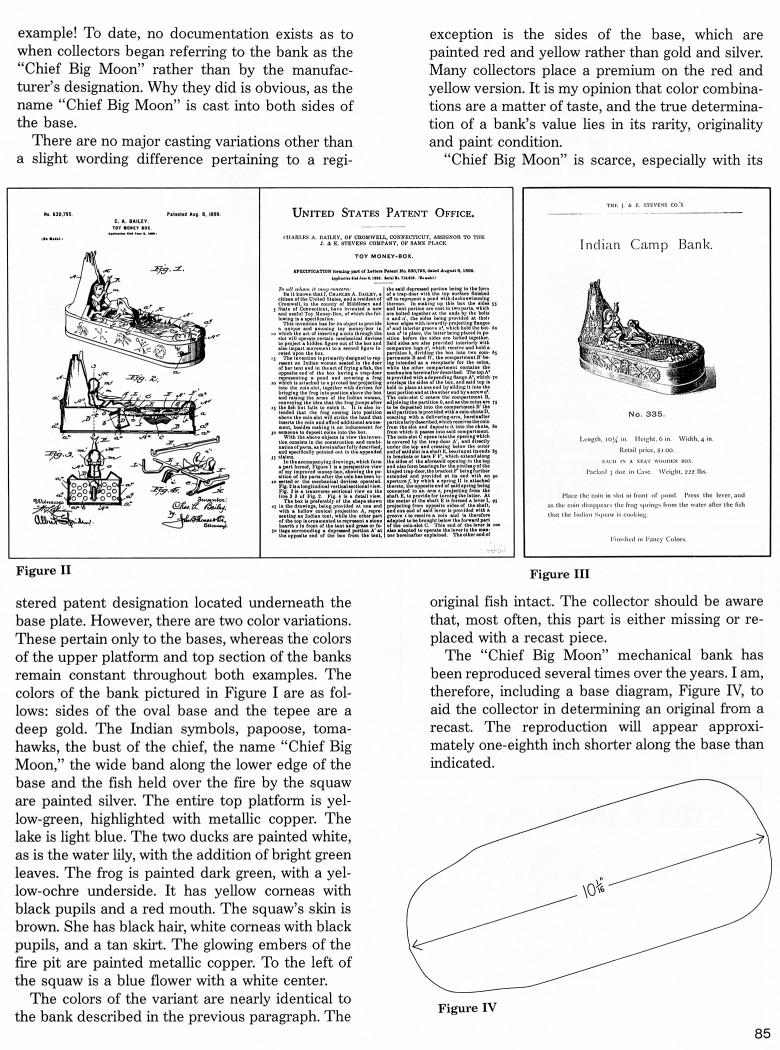|
The Chief Big Moon Bank
by Sy Schreckinger – ANTIQUE TOY WORLD Magazine – October, 1990
It may be stated, and appropriately so, that
most mechanical banks are charming and quite entertaining. However, few
possess the imaginative quality of the subject of this article, the "Chief
Big Moon" bank (Figure I).
It has never been established whether Charles A. Bailey, inventor of
the bank, derived the idea for its subject matter from an old American
Indian folk tale. Or was it, perhaps, the product of his own fertile
imagination? The godlike representation of the frog most certainly imparts
a mythical quality to this bank.
Description of the bank's action might suggest an old Indian legend:
a squaw sits at the entrance of her tepee, cooking a freshly caught fish
over the glowing embers of a dying fire. Before her lies the serene water
of Big Moon Lake. Insertion of a coin into the slot directly under the
fish results in the sudden emergence of a large frog from the lake, whose
intent is to devour the squaw's meal. She then pulls the fish from the
bold amphibian's reach and, simultaneously, the coin drops into the base.
"Chief Big Moon" has a small operating lever located at the left of
the fire pit. This enables the aforementioned action to be initiated
without utilization of a coin. Many collectors are of the belief that the
bank is activated solely by this lever; however, as stated within the
patent papers (Figure II), this was not the inventor's intent.
In order to reset the bank, the hinged lake is lifted and the frog is
returned to its hiding place within the base of the bank. Deposited coins
are retrieved by removal of a round, Stevens-type coin retainer underneath
the base.
Invention of this mechanical is attributed to Charles A. Bailey of
Cromwell, Connecticut. He was granted Patent Number
630,795 for its design
on August 8, 1899 (Figure II). For the sum of $1200, he assigned all
rights for its manufacture and eventual marketing to his employer, the J.
and E. Stevens Company of Cromwell, Connecticut. As evidenced by the
patent drawings, Figure II, and the final production bank, Figure I, the
Stevens Company adhered closely to Bailey's design.
Figure III represents a page from an early twentieth-century J. and
E. Stevens catalog which offered the "Indian Camp" bank for $1.00, each
packed in its own wooden box. Quite an investment when one considers the
recent selling price of a fine example! To date, no documentation exists
as to when collectors began referring to the bank as the "Chief Big Moon"
rather than by the manufacturer's designation. Why they did is obvious, as
the name "Chief Big Moon" is cast into both sides of the base.
There are no major casting variations other than a slight wording
difference pertaining to a registered patent designation located
underneath the base plate. However, there are two color variations. These
pertain only to the bases, whereas the colors of the upper platform and
top section of the banks remain constant throughout both examples. The
colors of the bank pictured in Figure I are as follows: sides of the oval
base and the tepee are a deep gold. The Indian symbols, papoose,
tomahawks, the bust of the chief, the name "Chief Big Moon," the wide
band along the lower edge of the base and the fish held over the fire by
the squaw are painted silver. The entire top platform is yellow-green,
highlighted with metallic copper. The lake is light blue. The two ducks
are painted white, as is the water lily, with the addition of bright green
leaves. The frog is painted dark green, with a yellow-ochre underside. It
has yellow corneas with black pupils and a red mouth. The squaw's skin is
brown. She has black hair, white corneas with black pupils, and a tan
skirt. The glowing embers of the fire pit are painted metallic copper. To
the left of the squaw is a blue flower with a white center.
The colors of the variant are nearly identical to the bank described
in the previous paragraph. The exception is the sides of the base, which
are painted red and yellow rather than gold and silver. Many collectors
place a premium on the red and yellow version. It is my opinion that color
combinations are a matter of taste, and the true determination of a bank's
value lies in its rarity, originality and paint condition.
"Chief Big Moon" is scarce, especially with its original fish intact.
The collector should be aware that, most often, this part is either
missing or replaced with a recast piece.
The "Chief Big Moon" mechanical bank has been reproduced several
times over the years. I am, therefore, including a base diagram, Figure
IV, to aid the collector in determining an original from a recast. The
reproduction will appear approximately one-eighth inch shorter along the
base than indicated.
|


